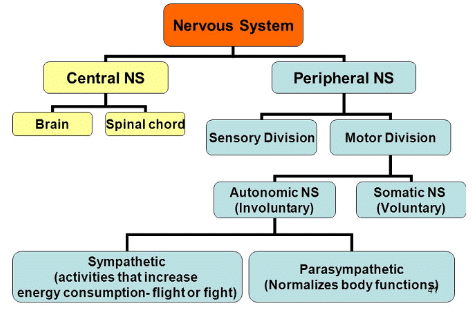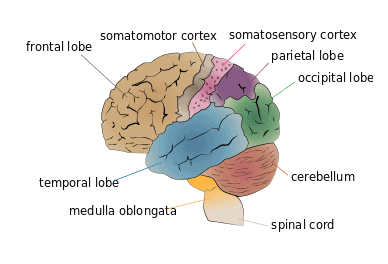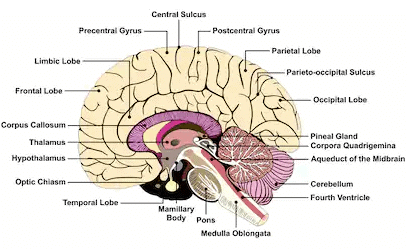Central Nervous System & Human Brain | Science Class 10 PDF Download

Central Nervous system (CNS):
- CNS consists of the brain and the spinal cord.
(A) BRAIN
- Brain is the most important part of human body.
- Brain is situated in a cranial box (cranium) which is made of bones.
- Meninges(Menix): Brain is covered by three membranes of connective tissue, termed as meninges.
(i) Dura Mater: It is the first and the outermost membrane which is thick, very strong and nonelastic.
(ii) Arachnoid Mater: It is middle, thin, delicate and non-vascular membrane found only in mammals.
(iii) Pia Mater: It is innermost, most vascular, thin and transparent membrane.
The space between the arachnoid and pia mater is filled with a fluid called cerebrospinal fluid (CSF). It protects the brain from mechanical shocks.
Meningitis: Any inflammation of meninges is called meningitis.
Weight of brain: In adult male 1400 gm, female 1250 gm.
Parts of Brain:
| (1) Fore brain | (a) Cerebrum | (b) Diencephalon | |
| (2) Mid brain | (a) Crura cerebri | (b) Corpora quadrigemina | |
| (3) Hind brain | (a) Cerebellum | (b) Pons | (c) Medulla oblongata |
(1) Forebrain (Prosencephalon):
(a) Cerebrum (Telencephalon):
- It is the most developed and the most complex part of brain.
- It makes 2/3 part of total brain.
- Cerebrum consists of two cerebral hemispheres. (Left and right cerebral hemispheres)
- Outer part of cerebral hemispheres is known as cerebral cortex.
- Both cerebral hemispheres are connected by a thick nerve band called corpus callosum.
- Many ridges and grooves are found on dorsal surface of cerebral hemisphere.
- Ridges are known as gyri, whereas grooves are known as sulci.
- These gyri and sulci increase the surface area of brain.
- Each cerebral hemisphere is divided into 4 lobes:
(i) Anterior: Frontal lobe for intelligence, knowledge, abstract, reasoning,creative ideas and memory.
(ii) Middle: Parietal lobe for taste, writing, pain, touch and pressure.
(iii) Lateral: Temporal lobe for language, hearing and smell.
(iv) Posterior: Occipital lobe meant for vision.
 Fig: Various lobes of cerebrum
Fig: Various lobes of cerebrum
 Fig: Median section of the brain
Fig: Median section of the brain
(b) Diencephalon:
- It is small and posterior part of fore brain.
- It is covered by cerebrum.
(i) Thalamus:
- They act as relay station.
- They receive all sensory impulse from all parts of body and these impulses are send to the cerebral hemispheres.
(ii) Hypothalamus:
- It forms lower lateral wall of diencephalon.
- A cross like structure is found on anterior surface of hypothalamus called as optic chiasma.
- Pituitary body is attached to middle part of hypothalamus by infundibulum.
Functions:
- Thermoregulation
- Behaviour and emotion
- Endocrine control
- Biological clock system
- The centres of feeling pain, hunger and thirst are present in it.
(iii) Epithalamus:
- It forms the roof of diencephalon.
- Pineal body is attached to it.
(2) Mid brain (Mesencephalon):
- It is small and contracted part of brain.
(a) Cerebral peduncles (Crura cerebri):
- Anterior part of mid brain contains two longitudinal myelinated thick nerve fibres, called crura cerebri.
- They connect the medulla oblongata of hind brain to cerebrum of fore brain.
- It controls the limb muscle movement.
(b) Optic lobes (Corpora Quadrigemina):
- On the posterior part of mid brain, four spherical projections are found, called optic lobes.
- Four optic lobes are collectively called corpora quadrigemina.
- These mainly control vision.
(3) Hind Brain (Rhombencephalon):
(a) Pons:
- It is small, spherical projection, which is situated below the mid brain and upper side of medulla oblongata.
- It regulates the breathing action.
(b) Cerebellum:
- It is made up of 3 lobes (2 lateral lobes and 1 vermis).
- Lateral lobes are also called cerebellar hemisphere.
Function: To maintain body balance & posture. It is responsible for precision of voluntary actions.
(c) Medulla oblongata:
- It is the posterior-most, tubular and cylindrical part of brain.
- The lower end medulla extends in the from of spinal cord.
Functions:
(i) It controls all the involuntary activities of the body. e.g. - heart beats, respiration, blood pressure salivation.
(ii) It also concerned with some reflexes- sneezing reflex, coughing reflex, vomiting reflex, yawning reflex.
| Difference between cerebrum and cerebellum | |||
| S.No. | Features | Cerebrum | Cerebellum |
| 1 | Part of | Fore brain | Hind brain |
| 2 | Size | Largest part of brain | Second largest part of brain |
| 3 | Function | Associated with intelligence, memory | Associated with body balance and posture |
(B) Spinal Cord
- It is a downward continuation of the medulla oblongata, which lies in the vertebral column.
Functions of spinal cord -
(i) Spinal cord regulates and conducts the reflex actions.
(ii) It acts as bridge between brain & organs of the body.
(iii) It also provides relay path for the impulses coming from brain.
REFLEX ACTIONS
- "Marshal Hall" first observed the reflex actions.
- Reflex actions are spontaneous, automatic, involuntary, mechanical responses produced by specific stimulating receptors.
- Reflex actions are completed very quickly as compared to normal action .
- The path of completion of reflex action is called "reflex arc".

Examples:
(i) Watering in mouth on sight of food
(ii) Closing of eyes when flashed with strong light.
(iii)Withdrawal of hand when pinched with a needle.
(iv)Blinking of eyelids, gut peristalsis, yawning, sneezing, coughing.

PERIPHERAL NERVOUS SYSTEM:–
- All the nervous arising from brain and spinal cord are included in peripheral nervous system.
- PNS consists of two sets of nerves:–
(A) Cranial Nerves:–
- Nerves arising from brain are called cranial nerves.
- Nerves may be sensory, motor or mixed.
- 12 pairs of cranial nerves are found in reptiles birds and mammals but amphibians and fishes have only 10 pairs.
(B) Spinal Nerves:–
- Nerves arising from spinal cord.
- Each spinal nerve is mixed type and arises from the roots of the horns of grey matter of the spinal cord.
- In humans, only 31 pairs of spinal nerves are found.
AUTONOMIC NERVOUS SYSTEM (ANS)
- The autonomic nervous system is that part of the peripheral nervous system which controls activities inside the body that are normally involuntary.
- ANS plays an important role in maintaining the constant environment. (Homeostasis) ·
- There are the two divisions of the ANS:–
(a) Sympathetic nervous system
(b) Parasympathetic Nervous system.
(a) Sympathetic Nervous System:–
- SNS is related with such visceral reactions, which increase the protection of body in adverse atmospheric conditions.
(b) Para sympathetic Nervous System:–
- PNS is related with those reactions in which energy is conversed.
- In this way, ANS controls the activities of visceral organs double side i.e. antagonistic to each other.
| Effects of sympathetic and parasympathetic nervous system | |||
| S. No. | Organs involved | Sympathetic effect | Parasympathetic effect |
| 1 | Eyes | Dilation of pupil | Constriction of pupil |
| 2 | Bronchi | Dilates | Constricts |
| 3 | Heartbeat rate | Increases | Decreases |
| 4 | Blood pressure | Increases | Decreases |
| 5 | Blood vessels | Constricts | Dilates |
| 6 | Gastric secretion | Inhibits | Stimulates |
| 7 | Urinary bladder | Relaxes | Contracts |
SPECIAL POINTS
- Cerebrospinal Fluid (C.S.F):– This fluid is clear and alkaline in nature just like lymph. C.S.F is present in ventricle of brain, subarachnoid space between arachnoid and piamater and spinal cord. It acts as shock absorbing medium.
- Broca's area: It is motor speech area, present in frontal lobe of cerebrum. If it gets destroyed the animal becomes unable to speak.
- In human brain more than 100 billion neurons are present.
- In mammals the speed of nerve impulse is 100-130 m/sec.
- Grey matter: It is composed of cytons and non-medullated nerve fibres.
- White matter: It is composed of medullated nerve fibres.
- Electroencephalograph: is an instrument which records the electrical activity of the brain in the form of a graph of electric potentials generated with time. Such a record in called electroencephalogram (EEG). The electroencephalogram (EEG) of a patient is done by placing two electrodes of electroencephalograph instrument on the scalp of the patient. Then a record of four different types of waves (a, b, d and q) is produced on the graph paper. These waves vary in their frequency. These waves give the characteristic activity of the brain of a person. The EEG of a patient is useful to diagnose brain ailment.
|
85 videos|437 docs|75 tests
|
FAQs on Central Nervous System & Human Brain - Science Class 10
| 1. What is the central nervous system? |  |
| 2. How does the central nervous system function? |  |
| 3. What is the role of the human brain in the central nervous system? |  |
| 4. How is the central nervous system protected? |  |
| 5. Can the central nervous system be affected by diseases or injuries? |  |

|
Explore Courses for Class 10 exam
|

|


















